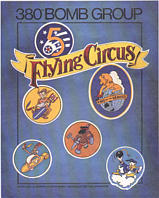
 |
380th Bomb
Group Association
|
The format used in presenting the data concerning each combat mission carried out by each individual aircraft of the 380th Bomb Group is as follows:
FURTHER EXPLANATION OF INFORMATION CONTAINED IN EACH ENTRY
As noted in the Introduction, the 380th Bomb Group spent most of its almost two-year service in the Australia/New Guinea area under the operational control of the Northwest Area Command, Royal Australian Air Force (RAAF). However, on at least four different occasions, large elements of the Group were transferred to New Guinea to take part in expanded operations there, such as during major landings, etc. During this period, the 380th was under the direct control of the Fifth Bomber Command as were all the other heavy bombers of the 5th Air Force.
Needless to say, each of these organizations had different schemes for designating each mission for command purposes and for historical record keeping.
The Royal Australian Air Force used a numbering system from 1 to 49 to successively designate a group of missions. At first, these encompassed all offensive missions carried out from Northern Territory but with the arrival of the 380th, a separate count was kept of the 380th's missions and a separate list or listings for other squadrons with different aircraft.
Missions were coded in the records with a three-letter block followed by a number in the range of 1-49 or 50-99. The three-letter block was derived from the location of the unit's headquarters. Thus in the case of the 380th this three-letter block was FEN for Fenton Strip (June 1943-October 1944) or DAR for Darwin Air Base (October 1944-move to The Philippines in February 1945).
The numbers were assigned consecutively within blocks from 1-49 for regular missions and 50-99 for special missions such as searches for lost aircraft, RCM searches or other similar flights. Whenever the numeral 49 or 99 was reached, the numbering merely started over at 0 or 50 with no indication of how many times the cycle had been repeated. To correct this omission, the compilers of this listing have added a Roman numeral labeling to indicate the number of the series. Thus a mission might be labeled FEN-IV-26 or DAR-I-52 to indicate the 26th mission in the fourth series from Fenton for the first, or the 52nd special search mission originating in Darwin for the second. There were a total of 11 regular and three special series of missions labeled FEN and seven series labeled DAR, thus giving a potential of 1,025 missions for the 380th in Australia. The actual number is smaller than this since some missions were cancelled.
Whenever the 380th flew under Fifth Bomber Command control, a different numbering system was used. Missions in Bomber Command were numbered according to the numerical day of the calendar year followed by a one- or two-letter code identifying the mission itself for that day. Thus the designation, 61-B, would indicate the second mission scheduled for March 1, 1944. These missions were scheduled by Groups so a large number of letters was used in any one day.
| STRIKE: | To bomb designated target |
| RECCE: | Reconnaissance, a search mission to investigate the presence and mission of the enemy |
| SEARCH: | General survey of an area, looking for shipping, lost aircraft, etc. |
| RCM: | Radar Countermeasures, search and investigation of enemy radar; later, jamming of such radars |
Column 9, Remarks/Notes
All missions recorded here were taken from the Mission Records of the 380th Bomb Group as recorded at the National Archives of the United States, Annex II, Silver Spring, Maryland. As verified by the Mission Numbers recorded, all missions of the 380th in the Australia/New Guinea area have been listed here except DAR II-38, one of the missions for October 31, 1944, which is missing from the Archives themselves. Only missions so recorded are included. The sole exception to this here is the estimate of number of sorties per aircraft during the first deployment to New Guinea in May-June 1942. Here missions were recorded but no individual listing of aircraft involved in any one mission has surfaced. Hence the need for an overall average sorties tally per aircraft. No other source was considered except for confirmation or additional information.
It will be found that the resulting mission list will be equal to or
less than those recorded in other publications for the same aircraft. Not
knowing the methods of tally kept by the other authors, we cannot comment on
any such difference other than when it may have been caused by an inadvertent
and undetected omission by us in our development of our list.
Return to Part VI - Table of Contents |
Return to Part VI - Introduction |